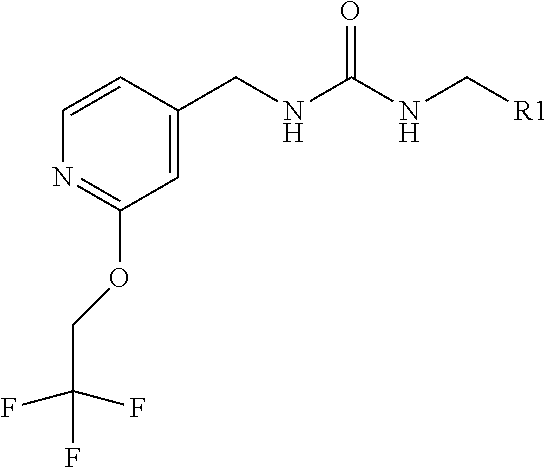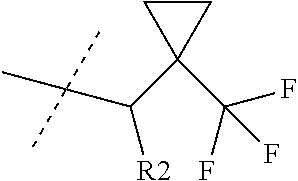Kcnq potentiators
a potentiator and kcnq technology, applied in the field of medicine, can solve the problems of calcium overload and cell death, progressive loss of motor neurons, muscle cramps and spasticity,
- Summary
- Abstract
- Description
- Claims
- Application Information
AI Technical Summary
Benefits of technology
Problems solved by technology
Method used
Image
Examples
preparation 5
(2S)-1-amino-3,3-dimethyl-butan-2-ol Hydrochloride
[0048]
[0049]Obtain (2S)-2-tert-butyloxirane commercially (CAS#40102-55-4) or via a kinetic resolution as reported in J. AM. CHEM. SOC. 9 VOL. 124, NO. 7, 2002 1307 wherein its reported that the R configured epoxide is obtained from the RR catalyst, hence the S epoxide is obtained from the SS catalyst:
[0050]Heat a mixture of (2S)-2-tert-butyloxirane (107 g, 1.01 moles) and NH4OH (1.3 L, 10.7 moles) in EtOH (427 mL) in a sealed vessel at 100° C. for 4 h. Cool and concentrate under reduced pressure. Dissolve the resulting residue in DCM (100 mL) at 0° C. and add a 4 M solution of HCl in dioxane (267 mL, 1.1 moles) slowly over 10 min while a white precipitate forms. Filter the resulting solid, wash with cold DCM, and dry by vacuum suction to give the title compound (103 g; 62.9% yield). 1H NMR (300.1 MHz, MeOD): □ 0.94 (s, 9H), 2.76 (dd, J=11.1, 12.6 Hz, 1H), 3.09 (dd, J=2.5, 12.6 Hz, 1H), 3.41 (dd, J=2.5, 11.1 Hz, 1H). [α]D20=+32.38° (c...
preparation 6
[2-(2,2,2-trifluoroethoxy)-4-pyridyl]methanamine dihydrochloride
[0055]
[0056]Stir 2-(2,2,2-trifluoroethoxy)pyridine-4-carbonitrile [CAS#618446-30-3] 82.5 g, 367 mmol) in EtOH (500 mL), decant the solution from the undissolved solid, and wash the solid with EtOH (3×50 mL) decanting the solution each time. Combine the EtOH solutions, dilute with additional EtOH (150 mL), and add an aqueous solution of conc. HCl (125 mL). Add a slurry of 10% palladium on carbon (3.7 g) in about 10 mL EtOH. Shake the resulting reaction mixture under an atmosphere of H2 at 60 psi at RT overnight. Filter the mixture through pad of diatomaceous earth, washing with EtOH, and concentrate the filtrate under reduced pressure to leave a white solid. Slurry the resulting solid in MTBE at 45° C. for 30 min, cool the mixture to RT, and filter to give a solid. Dissolve the solid in water (400 mL) and extract twice with MTBE (400 then 200 ml). Concentrate the aqueous phase under reduced pressure to give a cream color...
example 1
1-[(2 S)-2-hydroxy-3,3-dimethyl-butyl]-3-[[2-(2,2,2-trifluoroethoxy)-4-pyridyl]methyl]urea
[0057]
[0058]Stir [2-(2,2,2-trifluoroethoxy)-4-pyridyl]methanamine hydrochloride (8.06 g, 33.2 mmol) in DCM (50 mL) and add DIPEA (29 mL, 166 mmol). Stir the resulting mixture for 5 min and add 1,1′-carbonyldiimidazole (5.7 g, 33.2 mmol). Stir the mixture for for 10 min and add (2S)-1-amino-3,3-dimethyl-butan-2-ol hydrochloride (5 g, 32.5 mmol) and stir the resulting reaction mixture over the weekend. Wash the reaction mixture with water, separate the organic phase, and concentrate under reduced pressure. Purify the resulting residue by flash column chromatography on silica gel, eluting with 0 to 10% MeOH in DCM, to give the title compound (8.16 g, 72% yield) after solvent evaporation.
[0059]Combine material with another lot of the title compound (4.37 g) prepared as described above and recrystallize from iPrOAc (45 ml) to give 11.29 g of the title compound. ES / MS: m / z 350 [M+H]. [α]D20=+29.845° ...
PUM
| Property | Measurement | Unit |
|---|---|---|
| pressure | aaaaa | aaaaa |
| temperature | aaaaa | aaaaa |
| temperature | aaaaa | aaaaa |
Abstract
Description
Claims
Application Information
 Login to View More
Login to View More - R&D
- Intellectual Property
- Life Sciences
- Materials
- Tech Scout
- Unparalleled Data Quality
- Higher Quality Content
- 60% Fewer Hallucinations
Browse by: Latest US Patents, China's latest patents, Technical Efficacy Thesaurus, Application Domain, Technology Topic, Popular Technical Reports.
© 2025 PatSnap. All rights reserved.Legal|Privacy policy|Modern Slavery Act Transparency Statement|Sitemap|About US| Contact US: help@patsnap.com



